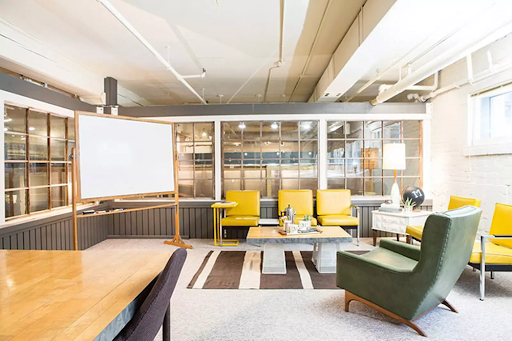
In recent years, the design world has witnessed a significant shift towards sustainability, with architects and designers emphasising creating environmentally-friendly and socially responsible spaces. As a thriving metropolis at the forefront of design innovation, Sydney has embraced this movement wholeheartedly, producing some of the most remarkable sustainable commercial interiors. These spaces showcase stunning aesthetics and beacons of sustainable design, incorporating eco-friendly materials, energy-efficient systems, and thoughtful practices. In this article, we’ll explore some of the best sustainable commercial interiors in Sydney and the trends shaping the future of eco-conscious design.
The rise of sustainable design in Sydney:
Realising the environmental impact of design and construction has fueled a collective desire within the industry to make a positive change. From office spaces to retail establishments, has seen a surge in sustainable commercial interiors in Sydney that prioritise not only aesthetics but also the well-being of the planet. Designers seek to create spaces that reduce energy consumption, minimise waste, and promote environmental responsibility.
Trends shaping Sydney’s commercial interiors:
Biophilic design integration:
Biophilic design, which emphasises the connection between humans and nature, is becoming increasingly prevalent in sustainable commercial interiors in sydney. The integration of natural elements such as plants, natural light, and organic materials promotes a healthier and more productive environment for occupants. Sydney’s designers are incorporating green walls, indoor gardens, and large windows to blur the boundaries between indoors and outdoors.
Circular economy principles:
The circular economy concept, where resources are kept in use for as long as possible through recycling and repurposing, influences interior design practices. Commercial interiors in Sydney embrace this concept using reclaimed and upcycled materials. Furniture, fixtures, and finishes sourced from salvaged materials contribute to a unique aesthetic and reduce the demand for new resources.
Energy efficiency and smart technology:
Energy-efficient lighting, heating, and cooling systems are becoming standard in commercial interiors. Sydney’s designers are incorporating smart technology to optimise energy consumption. Motion sensors, automated lighting controls, and smart thermostats ensure energy is used efficiently, minimising waste without compromising comfort.
Wellness and employee well-being:
Sustainable commercial interiors are not just about reducing environmental impact; they also prioritise the well-being of citizens. Designers in Sydney focus on creating spaces promoting employee health and wellness. Ergonomic furniture, quiet zones, and spaces for relaxation and even meditation contribute to a positive work environment, increasing productivity and job satisfaction.
Local sourcing and artisanal craftsmanship:
The importance of supporting local economies and reducing the carbon footprint of transportation has led to a trend of sourcing materials and furniture locally. Sydney’s sustainable commercial interiors often feature custom pieces crafted by local artisans. This adds a sense of uniqueness to the space and ensures that resources are obtained responsibly.
Adaptive reuse of historic buildings:
One of the exciting trends in sustainable commercial interiors in Sydney is the adaptive reuse of historic buildings. Designers are finding innovative ways to repurpose old structures while retaining their architectural heritage. This approach not only preserves the city’s history but also reduces the need for new construction and minimises waste. The Old Clare Hotel in Chippendale is a prime example of this trend. The hotel’s interiors seamlessly blend contemporary design elements with the building’s original features, creating a unique and sustainable space that pays homage to the past.
Zero-waste design philosophy:
The zero-waste design philosophy is gaining traction in Sydney’s sustainable commercial interiors. This approach aims to minimise waste generation throughout a space’s design, construction, and operational phases. Designers are implementing strategies such as using modular furniture that can be easily disassembled and reused, selecting recyclable or compostable materials, and implementing waste management systems that prioritise recycling and composting.
Community-centric spaces:
Sustainable commercial interiors in Sydney are increasingly focusing on creating spaces that serve the occupants and the surrounding community. Designers are incorporating elements that encourage interaction and engagement with the local neighbourhood. This trend is evident in spaces like The Commons in Darlinghurst, a co-working space that offers communal areas for events, workshops, and exhibitions. By opening up their spaces to the community, businesses foster collaboration and connection while promoting sustainability through shared resources and reduced transportation needs.
Integration of renewable energy sources:
A notable trend in Sydney’s sustainable commercial interiors is the integration of renewable energy sources to power these spaces. Solar panels, wind turbines, and other renewable energy technologies are being incorporated into building designs to generate clean and sustainable energy on-site. By harnessing the power of nature, these interiors are reducing their reliance on traditional energy sources and contributing to a greener and more resilient urban environment. This approach aligns with Sydney’s commitment to combat climate change and promote a sustainable future for future generations.
The future of sustainable commercial interiors in sydney:
As sustainability continues to gain superiority in design, the future of sustainable commercial interiors in Sydney is promising. The convergence of innovative technologies, thoughtful design practices, and a growing awareness of environmental impact is shaping a new era of responsible design. Designers and architects are likely to push the boundaries of sustainable design, experimenting with new materials, construction methods, and energy-saving solutions.
Conclusion:
Sustainable commercial interiors in Sydney are a testament to the city’s commitment to environmental responsibility, innovation, and design excellence. From adaptive reuse of historic buildings to zero-waste design principles and community-centric spaces, the trends shaping these interiors reflect a holistic approach to sustainability. As these trends continue to evolve, Sydney’s design community is leading the way in creating spaces that prioritise aesthetics and functionality and contribute positively to the environment and the well-being of those who inhabit them. With each new project, the city’s designers are pushing the boundaries of what is possible in sustainable commercial interior designs in Sydney, setting a precedent for a more eco-conscious and socially responsible future.
